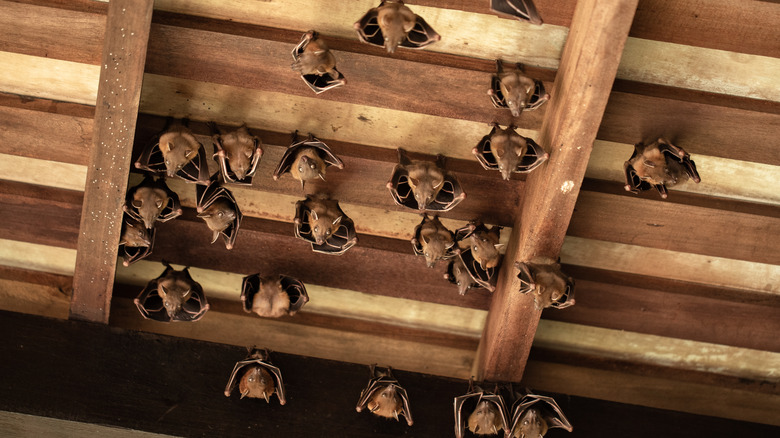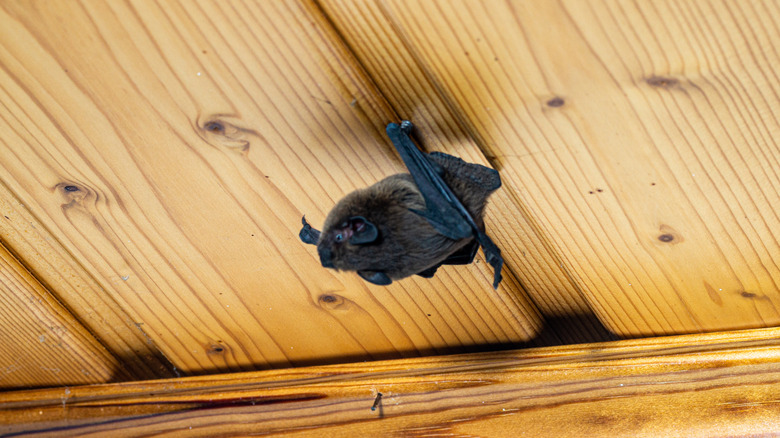Dead Giveaways That Bats Are Secretly Living In Your Attic
Bats are endlessly fascinating, but even the most devoted fan of the nocturnal mammals may draw the line at letting them move in. Unfortunately, bats often use attics as summer roosts, entering and exiting through small gaps and cracks in homes. If you're trying to figure out if bats have moved into your attic, some dead giveaways to look out for include persistent noises coming from your attic or walls, strange discolorations on your home's exterior, bat droppings in your attic, and a bat in your living area.
As undesirable as bats may be when they're secretly living in your attic, they're actually an essential part of the ecosystem. They not only pollinate many plants that bloom at night but also help control insect populations. One little brown bat (Myotis lucifugus) can eat 500 insects in an hour, and some of their favorite snacks include pests like mosquitos, cucumber beetles, and stink bugs. Because of the important roles bats play and the fact that many species are endangered or declining in numbers, bats are protected in most of the United States. If it turns out that they are, in fact, living in your attic, a wildlife exclusion company can help you with removing bats from your home humanely and responsibly. They can also ensure that they don't move back in. If you end up evicting bats from your attic, consider building a bat house nearby for them to relocate to.
Sounds and smudges can be signs of bats
Strange squeaking and scratching noises from walls or ceilings are never a good sign and could suggest a variety of interlopers, including rats, mice, or bats. One way to tell the difference is to knock on the wall where the noise is coming from. If the scratching or chirping noise continues, that can be a good sign of bats. On the other hand, if it stops for a short period and then begins again, you may be dealing with another type of pest. If you have bats, you're also far more likely to hear noises during warmer months, as bats hibernate during winter.
Another sign that bats are sharing your home is dark smudges on odd parts of your house's exterior. These smudges are caused by the oils on the bats' fur as they brush against things while squeezing through cracks to enter your attic and are typically brown in color. Be sure to check around any crevices or possible openings, paying extra attention to areas around chimneys, cracked siding, and damaged fascia. If you notice smudges, look around your attic for more possible signs of these creatures.
Bat droppings and a bat in your living area can signal infestations
Bat droppings, or guano, in your attic are a sure sign bats have been there. This guano looks similar to mouse droppings but is more likely to be in clusters, showing areas where bats roosted. It may also have speckles from insect wings, is typically larger than mouse droppings, and generally crumbles into a fine powder. This feces, as well as their urine, could also give off a stench that you may be able to smell before you spot it. Because bat guano can carry disease, be sure to wear a mask and gloves when examining your attic.
If you find a bat swooping in circles around your living room or bedroom, that is also a possible sign that there are far more bats nearby, maybe even in your attic. While it is tempting to tell yourself that it is just one bat and may have flown in through an open window, the other less appealing possibility is that it has been living in your attic with the rest of its colony and accidentally wandered into your living area. This is an especially common occurrence in mid to late summer when young bat pups are first learning to fly. Another similar sign is if you often see bats circling around your home at night, as they may have come from inside your space. If you discover that these creatures are in your house, discover some of the best ways to remove bats from your attic.


